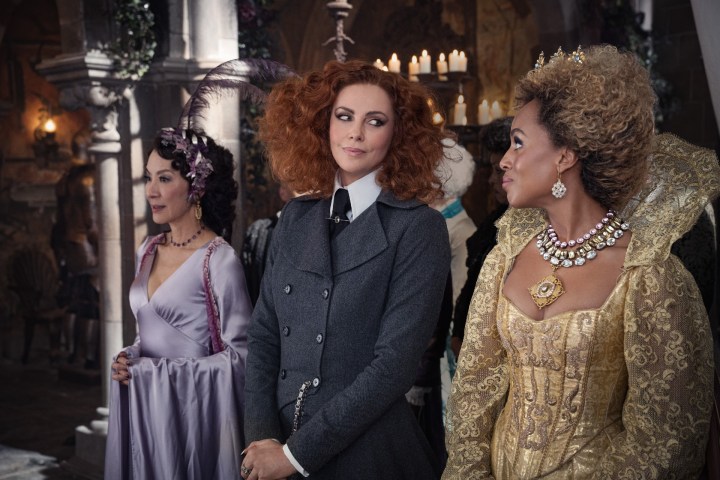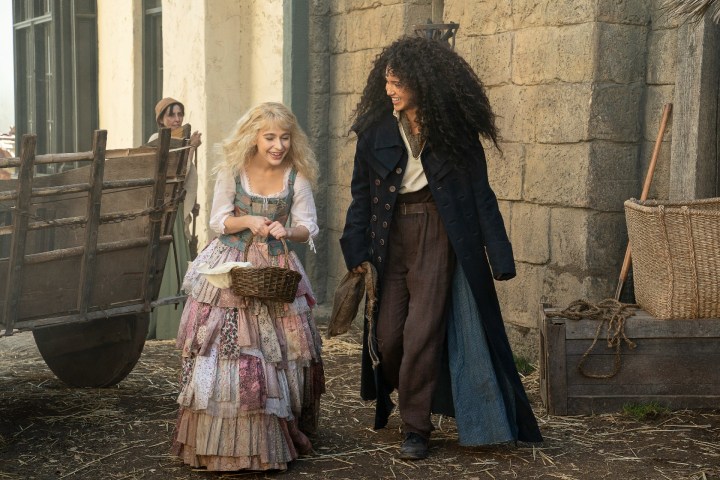Adaptations of young-adult fantasy literature have always been a little hit-or-miss, but that hasn’t stopped Hollywood from churning them out — and occasionally putting plenty of star power behind them, too.
Director Paul Feig’s The School For Good and Evil is the latest film to bring a popular YA series to the screen, and is based on Soman Chainani’s 2013 novel of the same name, which went on to spawn five sequels set in its fairy-tale universe. Along with its core cast of young actors, the film also features an impressive lineup of A-listers in supporting roles, and their presence keeps an otherwise formulaic fantasy adventure entertaining.

A fairy-tale cast
Co-written by Feig and Academy Award nominee David Magee (Finding Neverland), The School For Good and Evil follows best friends Agatha and Sophie, played by Sofia Wylie and Sophia Anne Caruso, respectively, whose mundane lives are upended when they find themselves spirited away to a magical school where heroes and villains are trained for fairy-tale adventures. Sophie’s belief that her placement in the School of Evil is a mistake complicates the duo’s arrival, and the entire school is quickly thrown into disarray when sinister forces conspire to benefit from all the chaos.
Wylie and Caruso are joined in the cast by Kerry Washington and Charlize Theron as the head professors at the schools for good and evil, respectively. Laurence Fishburne portrays the school’s headmaster, while Michelle Yeoh plays another professor at the school for good, and Cate Blanchett voices the school’s historian — a magical, sentient quill forever recording the students’ stories.
Serving double duty on two YA properties while playing dual roles in The School For Good and Evil, actor Kit Young (Shadow and Bone) plays both of the two powerful brothers whose rivalry led to the creation of the school.

The supporting stars shine
Wylie and Caruso do a fine job of keeping the story rolling along, even as it heads in predictable directions a little too frequently. The pair’s on-screen chemistry doesn’t quite scream “lifelong friends” or match up with the intense loyalty they profess to have for each other, but the two actresses have fun with their respective roles — particularly Caruso, who throws herself into the opportunity to play both ditzy princess and vamping villain archetypes.
Given the high profiles of the film’s supporting cast, it shouldn’t come as much of a surprise that the two leads are often overshadowed by the veteran actors around them, but it’s still a bit disappointing to see Wylie and Caruso’s characters fade into the background as often as they do. Theron is always great in villain roles (or any role, for that matter), and takes full advantage of the opportunity to camp it up as the playfully sinister Lady Lesso. Washington and Yeoh similarly elevate their goody-goody roles from obnoxiously positive to over-the-top silly, keeping the story fully rooted in its fairytale aesthetic.
And although he’s given minimal screen time in the film, Young continues to make a strong case for himself as an actor who enriches anything he’s in these days, whether it’s playing a charming gunslinger in Shadow and Bone or the avatars of good and evil in this film.

A very long tale
While the underlying story in The School For Good and Evil doesn’t offer much in the way of surprises and occasionally seems to get lost in the mythology of its own universe, the performances of the film’s cast are generally enough to maintain the film’s energy. Their ability to do so is tested, though, by the film’s surprisingly long running time, which clocks in at nearly two-and-a-half hours.
The aforementioned performances and a parade of visual effects-heavy sequences do a nice job of keeping your eyes off the clock, but The School For Good and Evil never quite justifies its lengthy running time with the sort of expansive story or world-building you expect from that level of time investment. It’s a pretty-looking (and pretty funny) film with some promising narrative threads for future sequels or spin-ffs, but even the most entertaining elements of the film wear a little thin around the second hour.
Overall length aside, The School For Good and Evil delivers just enough on its potential to provide a stable foundation for what Netflix is certainly hoping will become a new fantasy franchise. The world it introduces is full of potential — as limitless as the number of fair tales, fables, and legends it can draw from, in fact. That’s a lot of source material, but only time will tell if audiences give it the level of attention Netflix would need to expand on the premise and lore introduced in the film.
While it falls a bit short of being the next big thing for YA fantasy adaptations or its streaming home, Netflix, The School For Good and Evil provides enough intriguing, entertaining, and otherwise satisfying elements to give it a fighting chance in a crowded genre. Its impressive supporting cast delivers some of the film’s best moments, but don’t be surprised if its extended running time makes you eager to hear the school’s dismissal bell.
Directed by Paul Feig, The School For Good and Evil premieres October 19 on Netflix.





